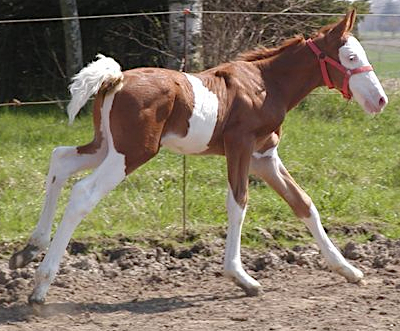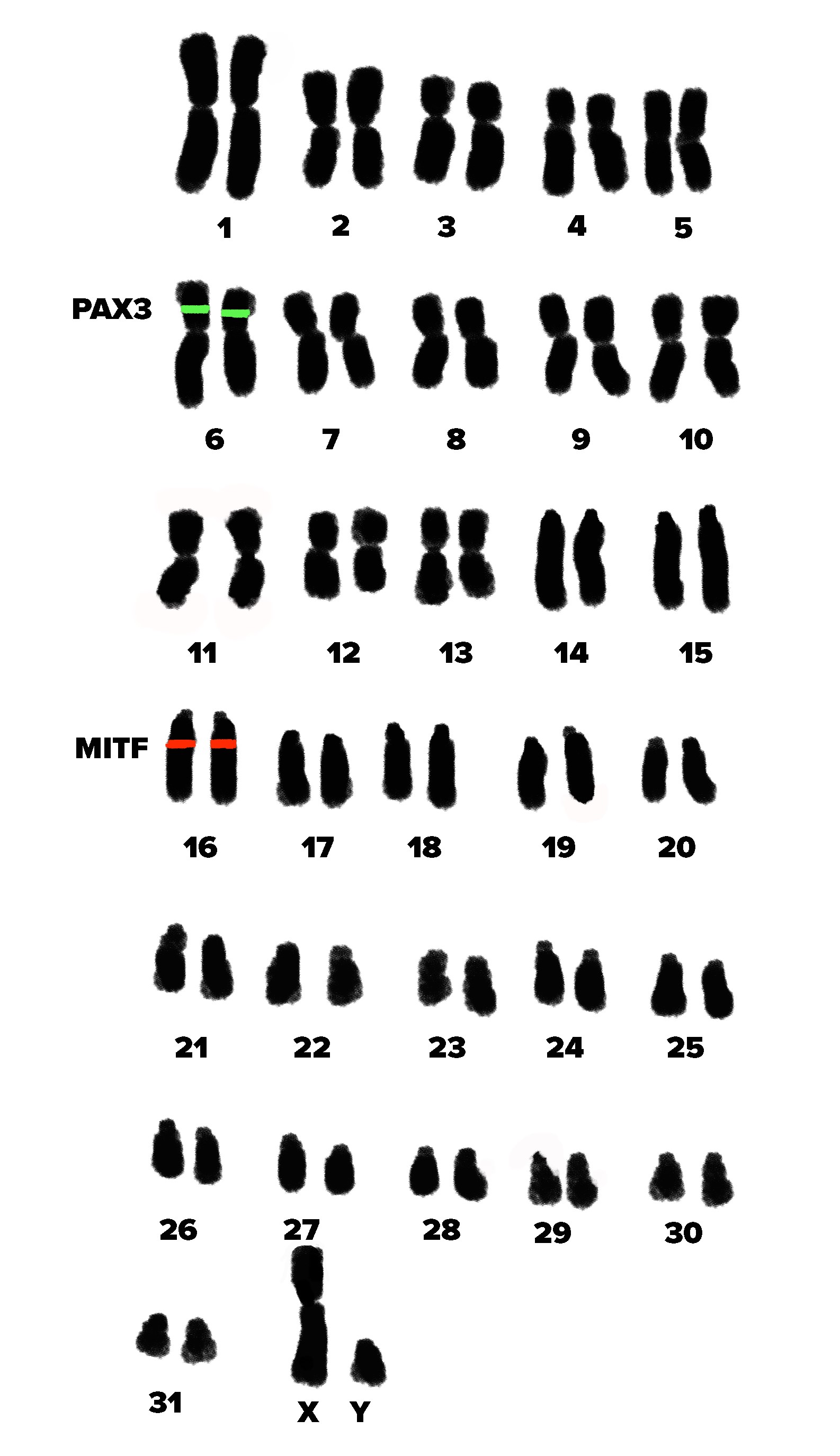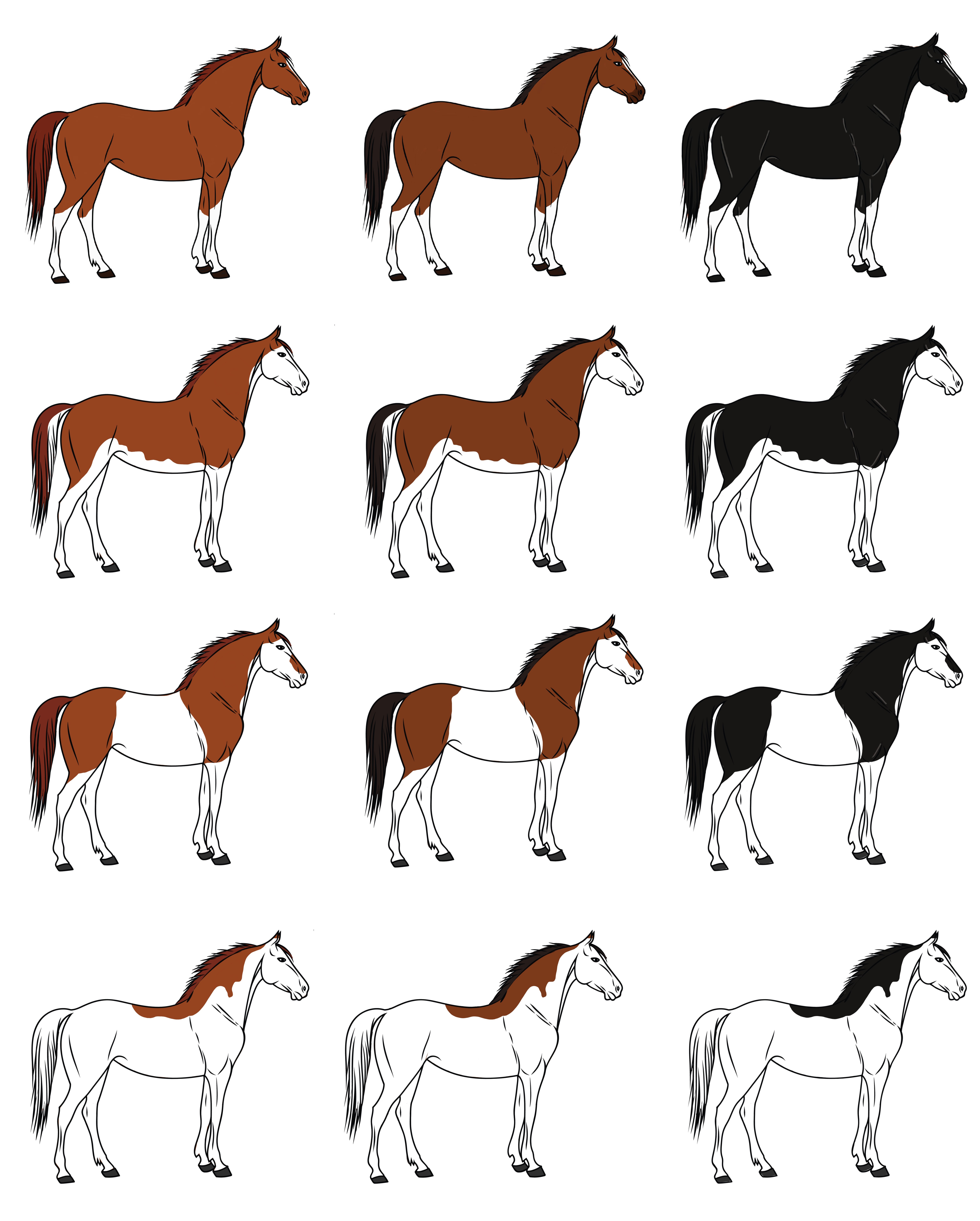Quick Summary

Click here for Price and Turnaround Time
Phenotype: Splashed white is a variable white spotting pattern characterized often by a large broad blaze, extended white markings on the legs, variable white spotting on the abdomen (belly), and often horses with this pattern have blue or partially blue eyes.
Mode of Inheritance: Autosomal dominant
Alleles: N = Normal/Unaffected, SW1/SW2/SW3/SW4/SW5/SW6/SW7/SW8 = Splashed white 1/2/3/4/5/6/7/8. SW2/4 are variants of the PAX3 gene and SW1/3/5/6/7/8/ are variants in the MITF gene.
Breeds appropriate for testing:
SW1: Appaloosa, Finnhorse, Dutch Warmblood, Gypsy Cob, Icelandic Horse, Knabstrupper, Miniature Horse, Morgan Horse, Paint Horse, Quarter Horse, Shetland Pony, Welsh Pony, Thoroughbred, Trakehner, Pony of the Americas
SW2, SW3, SW6, SW7: Quarter Horse and Paint Horse
SW4: Appaloosas
SW5: Paint Horse
SW8: Thoroughbred

Explanation of Results:
- Horses with N/N genotypes do not have the splashed white pattern caused by SW1-SW8. The appearance of a typical splashed white spotting pattern in an N/N horse may be caused by a different white spotting mutation or a yet unknown genetic variant.
- Horses with N/SW1, N/SW2, N/SW3, N/SW4, N/SW5, N/SW6, N/SW7, or N/SW8 genotypes have a splashed white patterning that can vary in amount of white patterning. They may transmit a splashed white variant to 50% of their offspring. Matings with N/N genotype will result in a 50% chance of producing a foal with splashed white patterning.
- Since splashed white variants are found in two genes it is possible for horses to have SW1, SW3, SW5, SW6, or SW7 as well as SW2 or SW4. The number of SW variants impacts the chances of producing splashed white offspring. For example, a horse with one copy of SW1 (SW1/N) who also has one copy of SW2 (N/SW2) will have a 75% of producing a horse with at least one splash white variant when bred to horses that are N/N.
- Horses homozygous for a splashed white variant or compound heterozygous will pass their SW allele onto all offspring. Matings of horses with the genotypes below are predicted to produce splashed-white offspring with variable amount of white patterning.
MITF#: SW1/SW1, SW1/SW3, SW1/SW5*, SW1/SW6, SW1/SW7* SW1/SW8*, SW3/SW5*, SW3/SW6*, SW3/SW7*, SW3/SW8*, SW5/SW6*, SW5/SW7*, SW5/SW8*, SW6/SW7* SW7/SW8*
PAX3#: SW2/SW2, SW2/SW4*, SW4 /SW4*
#Horses homozygous for the SW3, SW4, SW5, SW6, SW7 and SW8 variants (SW3/SW3, SW4/SW4, SW5/SW5, SW6/SW6, SW7/SW7, SW8/SW8 genotypes) have not been detected and may be embryonic lethal.
*Through testing and research, the VGL has not identified any SW1/SW5, SW2/SW4, SW3/SW5, SW3/SW6, SW4/SW5, SW4/SW6 or SW5/SW6 compound heterozygotes. It is unknown at this time if these combinations are non-viable or just not yet detected because of the low frequency of SW5, SW6, SW7 and SW8.
White Pattern Panel 1
$65 per animal
White Pattern Panel 2
$85 per animal
Appaloosa Panel 1
$65 per animal
Full Color/Pattern Panel
$155 per animal
Sample Collection
Horse DNA tests are carried out using cells from the roots of a hair sample (roughly 20-40 hairs).
1. Grab about 10 hairs at the base.
2. Wrap the hairs around your finger and give it a quick pull.
3. Check the ends to make sure the pulled hairs have roots.
4. Repeat the process until you have collected about 20-40 hairs with intact roots.
5. You can choose different places on the mane or tail. NOTE: For foals, we recommend pulling all hairs from the tail only.
6. Tape the hairs to the submission form and fold the form along the dotted line to protect the sample. Do not use ziploc bags as they can cause condensation that allows mold to grow on the hair.
7. Place the folded form containing the sample in a paper envelope and mail it to the laboratory.

Splashed white is a variable white spotting pattern characterized primarily by a large, broad blaze, extensive white markings on legs, variable white spotting on belly, and often one or two blue eyes. Some, but not all, splashed white horses are also deaf. Eight mutations have been identified that cause this phenotype and have been named in the order they were discovered: SW1, SW2, SW3, SW4, SW5, SW6, SW7 and SW8. All of these mutations cause a similar splashed white phenotype in horses although the amount of white patterning is variable and thought to be controlled by other genes. Some are known, but mostly these additional genes, contributing to the variation in splash white phenotype, are yet to be identified.
Splashed white is inherited as a dominant trait with variable expression, which means that one copy of a SW mutation will produce a white spotting phenotype with variable amount of white patterning. Horses that carry combinations of the splashed white mutations, tobiano, or lethal white overo can display extensive white patterning or their coats maybe entirely white.
Testing for the splashed white pattern allows breeders to identify which splashed white variant is present in their horse and can aid in breeding decisions and identifying horses to evaluate clinically if deafness is suspected.
MITF - SW1, SW3, SW5, SW6, SW7 and SW8
SW1, SW3, SW5, SW6, SW7 and SW8 are all variants in the MITF (microphthalmia associated transcription factor) gene. MITF is an important protein for normal pigment cell function. It is a transcription factor that activates other genes in the pigment process including those known to regulate melanocyte proliferation and migration.
SW1 is found in many breeds – research at the VGL identified it in Quarter Horse, Appaloosa, Paint Horse, Morgan Horse, Trakehner, Miniature Horse, Shetland Pony, Dutch Warmblood, Gypsy Cob, Welsh Pony, Knabstrupper, and Icelandic Horse. It may be present in other breeds as well. The SW1 variant is a 10 bp insertion in the MITF promotor (chr16:g.20,117,302Tdelins11). The promoter is the region of the gene that regulates gene expression. SW1 is thought to disrupt the normal gene production thus impacting pigment cell division. Horses homozygous for SW1 (SW1/SW1) have been identified, providing evidence that this mutation is not homozygous lethal.
SW3 occurs exclusively in certain lines of Quarter Horses and Paint Horses and is caused by a frameshift mutation MITF (p.C280Sfs*20). SW3 is thought to be lethal in the homozygous state (SW3/SW3) as no individuals with this genotype have yet been identified. The current recommendation is that mating of two horses that carry SW3 should be avoided.
SW5 is a large deletion of 63 thousand nucleotides in the MITF gene (chr16:21,503,211–21,566,617). This variant removes several important regions of the gene and likely causes the gene to have a reduced or complete loss of function. This mutation was identified in an American Paint Horse family. Subsequent research at the VGL, suggest the frequency of this mutation is low in the Paint Horse breed. It is unknown if SW5 is homozygous lethal and no homozygotes have been reported.
SW6 was identified by research at the Veterinary Genetics Laboratory and like SW5 is a large deletion of the MITF gene, that likely inhibits proper function of the gene product. This deletion removes 8,710 nucleotides of the gene. It is predicted that this change in the DNA results in a shortened MITF protein (the product of the MITF gene). The region that is removed normally binds to the DNA of other pigmentation genes to activate them. The end result is white areas lacking pigment cells. At this time, it is not known whether homozygosity for SW6 (two copies of this mutation) is viable. Based on the type of mutation and the role MITF plays in development, we suspect that SW6/SW6 may be embryonic lethal. However, one SW1/SW6 compound heterozygote was identified as part of the VGL study.
SW6 was identified in a single family. An exciting finding to our study was identifying SW6 as a de novo (new/recent) mutation. More specifically, a de novo mutation means that the change in the DNA occurred either during the cellular processes that gave rise to the egg or sperm or during early embryonic development of the stallion investigated in the study. Being a de novo mutation also means only this individual, his offspring, and resulting future generations of horses originating with this stallion can have this mutation. Identification of a de novo mutation was an exciting finding because we know precisely the individual and generation in which the mutation occurred.
SW7 consists of a small deletion in the MITF gene (p.R317del) and was identified in a family of dual registered American Quarter Horse/American Paint Horse individuals who presented with an almost all white coat, except for some colored markings on the hindquarters, and owner reported deafness. It is unknown if SW7 is homozygous lethal, but one SW1/SW7 compound heterozygote was reported
SW8 consists of a large deletion of 2.3 thousand base pairs in the MITF gene (chr16:21555811-21558139). VGL researchers identified the mutation and determined this was also a de novo mutation in a Thoroughbred horse with a splashed white coat pattern. Our research also determined that this mutation occurred on the stallion’s maternal chromosome. Being able to identify which parental chromosome this variant occurred is a rare and exciting finding. SW8 was also identified in a nearly all-white offspring of the stallion that was clinically confirmed to be completely deaf. This all-white offspring is also a compound heterozygote for two dominant white alleles (W22/W20). It is unknown if SW8 alone or if the combination of the different white patterning alleles is was caused deafness in this offspring.
PAX3 - SW2 and SW4
SW2 and SW4 are mutations in the PAX3 (paired box gene 3) gene. SW2 is found in certain lines of Quarter Horses and Paint Horses and is caused by a missense mutation in PAX3 (p.Cys70Tyr). PAX3 is essential for proper development of some nerve tissue and pigment cells. Based on research at the VGL that identified SW2 homozygotes, homozygosity for SW2 is likely not lethal, though horses homozygous for SW2 may be deaf and should be clinically evaluated by a veterinarian. The rare SW4 mutation has been identified in family of Appaloosa horses and may cause a splashed white or a minimally a broad blaze. SW4 is caused by a missense mutation in PAX3 (p.Pro32Arg), and may be lethal in the homozygous state, though this remains to be determined.

 Splashed White Mutations – SW1, SW2, SW3, SW4, SW5, SW6, SW7 and SW8
Splashed White Mutations – SW1, SW2, SW3, SW4, SW5, SW6, SW7 and SW8